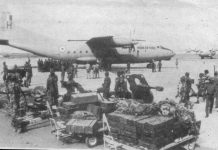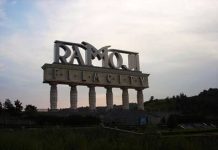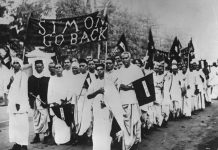Every soldier is a hero, but before that he is a son, a father, a brother and a husband. In spite of all these responsibilities, the greater responsibility that they shoulder is a country’s safety. India has seen many wars in the past century. Indian soldierswere part of World War 1 & 2 before Independence. India has fought wars with Pakistan 4 times since the partition and once with China and during these wars we lost a lot of good men. The achievements of some soldiers deserve a special mention. This is a list of 10 such brave soldiers of Indian army. Most of these men died in their efforts to save the country while some are still alive to tell their story.
Major Ramaswamy Parameswaran
Major Ramaswamy Parameswaran was part of Operation Pawan in 1987. The operation was assigned to the Indian Peace Keeping Force to take control of Jaffna from LTTE in Sri Lanka.
On November 25th, 1987 when Major Ramaswamy Parameswaran was returning late night from search operations, his troop was ambushed by a group of militants. He kept his cool and encircled the militants from behind and boldly charged towards them. The militants were completely taken back by the bold counter-attack by Indian troops. Ramaswamy Parameswaran charged ahead and engaged in hand-to-hand combat with one of the militantsand was shot in chest in the process. He snatched the rifle from the militant and shot him dead. In spite of being severely injured, he continued giving orders that inspired his troops even more. When the dust had settled, five militants were killed and their heavy weapons seized. He took his last breath on the same ground.
He was awarded the Param Vir Chakra, the highest wartime gallantry medal, posthumously.
Lance Naik Albert Ekka
Lance Naik Albert Ekka attached to the 14 Guards during Bangladesh Liberation War of 1971was assigned with the mission to capture a Pakistani position at Gangasagar. Gangasagar is on the border between Tripura and the present Bangladesh. This was a well-fortified position held in good numbers by the enemy.
The action commenced at 0400 hours on December 4th, 1971 when 14 Guards charged forward towards enemy positions with heavy shelling from the enemy and soon engaged in hand-to-hand combat. They soon were confronted by light machine-gun and pinned down inflicting heavy casualties on Indian side. Albert Ekka bravely charged forward towards the enemy bunker and bayoneted two enemies, finally silencing the machine gun. He in the process was severely injured, but continued to fight. His team had just cleared numerous enemy bunkers for 1.5 kilometers when they were confronted by a medium machine-gun from the second storey of a well-fortified building. Albert Ekka killed one enemy solider in the ground bunker and then proceeded to climb the sidewall of the two storey building to bayonet the enemy and silence the MMG. He accomplished the objective of mission, but later succumbed to his serious injuries.
He was awarded the Param Vir Chakra, the highest wartime gallantry medal, posthumously.
Captain Gurbachan Singh Salaria
Captain Gurbachan Singh Salaria was commissioned in third battalion regiment of 1st Gorkha Rifles. The regiment was part of the 3000-soldier Indian aid to the U.N. Peacekeeping Force during the Congo Crisis of 1961.
He was tasked with the job of clearing a roadblock set up by the Katangese troops on the road connecting the U.N. Headquarters and Katanga Headquarters. With the help of 3-inch mortar, the militant roadblock was destroyed and U.N. roadblock was established by the Gurkhas. During his efforts to link up with the Gorkha Company to reinforce the roadblock, he met strong opposition in an old open airfield area. The militants packed heavy artillery, 2 armored cars and consisted of 90 men in dug-in trenches. Undeterred by the superior number and firepower of the militants, Gurkhas under the command of Gurbachan Singh Salaria charged forward with their bayonets, kukris, hand-grenades and a rocket launcher. In the encounter, he was hit by a bullet in the neck, but with total disregard to his safety he continued to command and charge forward with his troops. About 40 militants were killed and the two armored cars were destroyed. Rest of the militants bolted the battlefield in a panic completely demoralized. Gurbachan Singh Salaria succumbed to his wounds due to excessive blood loss.
He was posthumously awarded Param Vir Chakra.
Naib Subedar Bana Singh
Quaid was a Pakistani post at the world’s highest battlefield in Siachen glacier at an elevation of approximately 6750 meters. It was a strategically very important post that India had to capture for safety concerns. As it was found out later, from this post they had a clear view of 80 km around, almost the entire Saltoro range including the Indian posts of Amar and Sonam, which were remote and were supplied only by a helicopter.
Operation Rajiv was launched to capture this post in three phases. The first two phases were unsuccessful with a number of causalities. On June 26, 1987, Naib Subedar Bana Singh with his handpicked team started ascending up the vertical cliff face under heavy snow and ambient light. Pakistanis became complacent due to the bad weather and treacherous terrain and were caught off guard by Bana’s team. His team was able to close up on the Pakistani bunker. Bana hurtled a grenade inside and closed the door. In short combat that resulted, six Pakistanisoldiers were killed, half of them bayoneted to their deaths. The post was successfully captured and named Bana Top in his honor.
Naib Subedar Bana Singh was later awarded Param Vir Chakra for his conspicuous bravery and leadership under difficult conditions.
Captain Vikram Batra
During Kargil War, Captain Vikram Batra (nicknamed Sher Shah) of 13 JAK Rifles and his company was assigned the mission to recapture Point 5140. The enemy bunkers on top of the Point 5140 were approximately at an elevation of 5100 meters. He planned to lead the rear of his team for a surprise attack to stun the enemy.
The team started ascending the sheer rock-cliff, but as they approached the top they were pinned down on the cliff face with machine gun fire. They reached top in spite of heavy artillery shelling and he hurled two grenades at the machine gun post. He single-handedly killed three Pakistani soldiers in hand-to-hand combat. In the process he was seriously injured, but asserted on reorganizing his team and continuing on with the mission. Inspired by his courage, the soldiers of 13 JAK Rifles charged the enemy positions and destroyed them, capturing Point 5140 in June 20, 1999. His team was credited with killing 8 enemy soldiers and capturing a heavy anti-aircraft gun. Batra then led his team to triumph with the recapture of Point 4750 and Point 4875. During his mission to recapture Point 4875, he was killed trying to rescue an injured soldier. His last words were “Jai Mata Di.”
Captain Vikram Batra was awarded Param Vir Chakra posthumously for his sustained display of conspicuous bravery and leadership.
Naib Subedar Yogendra Singh Yadav
When Kargil War broke out in 1999, Tiger Hill was captured by Pakistani army. Yogendra Singh Yadav of 18 Grenadiers was part of Ghatak Commandos, who were assigned to recapture the hill. The enemy bunkers were on top of the hill at an elevation of 5,300 meters above sea level. They planned to scale 1000 feet of sheer cliffs to reach the top and assault the three heavily fortified Pakistani Bunkers.
Yadav was trained in mountain climbing and alpine warfare and was the first to ascend the cliff, tasked with affixing a rope system to enable the troops behind him to scale the cliff. Halfway through the climb, he was met with rocket propelled grenades and the 12-18 soldiersfollowing him were all dead. He was shot twice in the shoulder and once in his groin. Wounded and bleeding he rushed the last 60 feet of the climb and reached the top. He proceeded to charge the first bunker directly in line of machinegun fire and hurled in a grenade killing everyone inside. He then ran up to the second bunker and proceeded to kill four-man machine gun team in hand-to-hand combat. By this point, a second team of Indian soldiers had scaled up and came to his rescue. He refused to leave without destroying the third bunker, which he and his team successfully achieved.
Param Vir Chakra was announced for Yadav posthumously, but soon it was discovered that he was recovering in a hospital, and it was his namesake, who had died during the mission. Recapture of Tiger Hills was the most important objective of Indian forces in Kargil War.
Rifleman Lachhiman Gurung
Lachhiman Gurung was a rifleman of the British Indian Army during World War II. In May of 1945, he was manning the forward position of his platoon in Burma. Suddenly his troops came under attack from 200 Japanese soldiers. Grenade attack killed most of his troops and others lay injured around him. He started hurling back the Japanese grenades that fell into his trench twice and in the third attempt the grenade exploded in his right hand severely injuring the whole right side of his face and body. With total disregard to his severe injuries, he loaded his riffle and started firing with his other good hand. He single handedly took on a troop of 200 Japanese soldiers for four hours. He calmly waited in his trench as the Japanese soldiers advanced, firing them at point blank range. In the morning on assessing the damage he had inflicted, 31 Japanese soldiers lay dead around his trench.
He received Victoria Cross, the most prestigious award for gallantry during those times at Red Fort in Delhi on December 19th, 1945. He died in December of 2010 of pneumonia in England.
Bishnu Shrestha
Bishnu Shrestha is a retired Indian soldier of Gurkha Infantry. On September 2, 2010 after retiring at the age of 35 he was on his way back to Nepal aboard Maurya Express. In the middle of the night, the train came to an abrupt halt in a jungle and 40 thugs entered the train. The thugs were armed with guns, swords, knifes and clubs. They started looting passengers of their valuables at knifepoint. When they came to Bishnu, he handed over his wallet to them peacefully, but when thugs attempted to rape an 18-year-old girl in his compartment, he intervened with his kukri knife. In the 20-minute action that followed, he raced through the aisles killing three and wounded at least eight of them with his kukri knife. The other 29 fled the scene to save their own lives leaving behind their loot.
In the scuffle he received serious blade injury to his left hand and took two months to recover. The girl received minor cuts to her neck. Her parents offered Bishnu large cash reward, but he denied the reward saying, “Fighting the enemy in battle is my duty as a soldier. Taking on the thugs on the train was my duty as a human being.”
He was awarded Sena Medal for bravery, and the Uttam Jeevan Raksha Padak medal for his gallant actions.
Company Havildar Major Piru Singh
During the 1947-48 Indo-Pak war, Pakistan had captured the village of Tithwal in the hills of Kashmir. Pakistanis positioned themselves well with machine gun nests covering all possible points of approach. Major Piru Singh was part of Rajputana Rifles and his troop was ordered to recapture this post in July of 1948. The only path leading to the enemy post was a narrow ridge that would funnel his team in direct line of fire of the machine guns. On the other side of the ridge was a sheer cliff to the valley below.
On his way to the top, Piru Singh had lost half of his company from intense machine gun fire. This did not deter him from advancing and shouting “Raja Ramchandra ki Jai” all the while. This encouraged his remaining men to charge forward with him. Splinters from grenade attacks and gunfire had ripped his clothes. He was heavily wounded, but without the least regard for his safety he reached the top to the enemy position and emptied all his rounds. By the time he ran out of ammo, all his associates were dead. This escalated his rage to the next level as he hurled grenades at another trench and bayoneted the occupants. In the process, a grenade hurled at him exploded injuring half of his face. Blind from one eye and bleeding from his injuries, he still gathered enough courage to step out of his trench and hurl another grenade at the second enemy position when he was hit by a bullet in the head killing him. The grenade he threw took out the last enemy position and thereby accomplishing his mission.
He was awarded Param Vir Chakra posthumously.
Second Lieutenant Rama Raghoba Rane
Rama Raghoba Rane was part of 37 Assault Field Company attached to 4 Dogra that was part of the action during 1947-48 Indo-Pak war. Indian troops were on pursuit from Naushahra to Rajauri through an old Mughal route. Things started to get a little intense as they advanced forward. Beyond Barwali, Pakistanis had placed numerous road blocks and minefields that had to be cleared for forward progression of the battalion. These roadblocks had heavy mortar nests that made it difficult even for the armored tanks to pass through.
On 8th April, Rane and some of his men were injured by heavy mortar fire while clearing mines. In spite of his severe injuries, he and his men worked through the night to clear the roadblocks and mines and even on the 9th of April for 12 continuos hours they toiled to clear these obstacles amidst heavy firing. The next day on 10thof April, he cleared the biggest road block consisting of 5 huge pine trees surrounded by mines under heavy artillery fire within two hours and on the next day he continued to clear road blocks for 17 more hours. The operation cost Pakistanis 500 soldiers.
For his valiant efforts despite his injury, he was awarded Param Vir Chakra, India’s highest war-time gallantry award. As of the time of writing this article, he still lives on to tell his story.









































